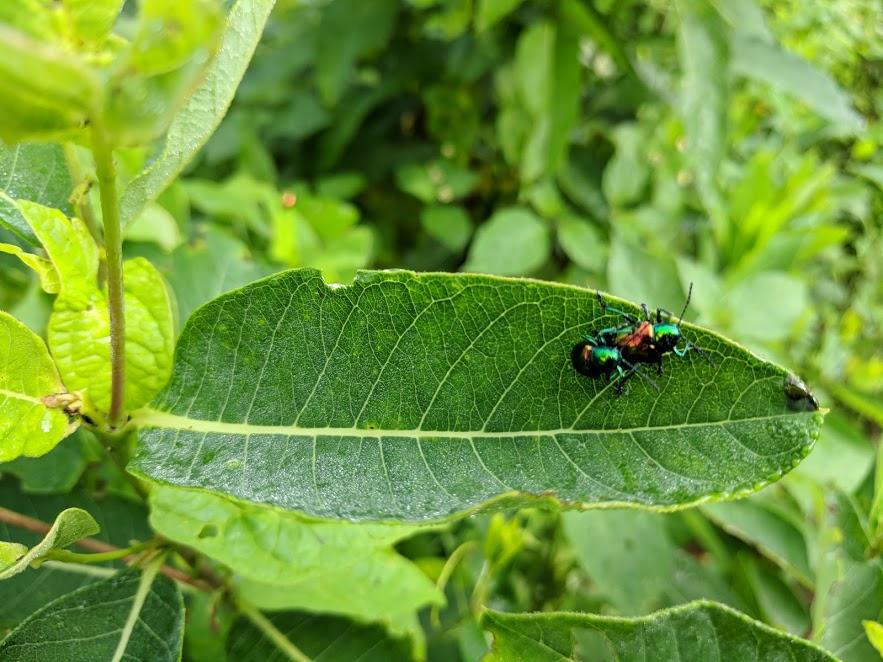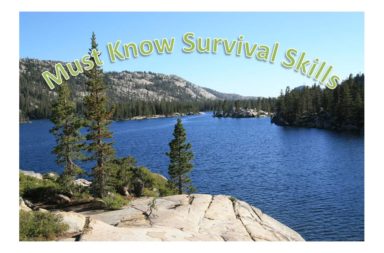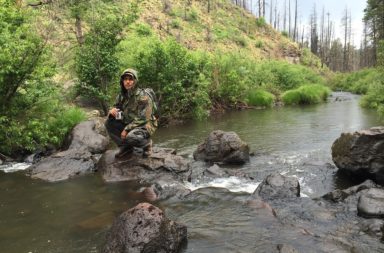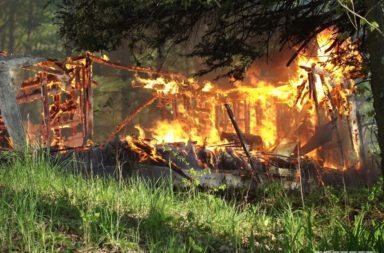Basic disaster preparation for any grid down situation can be said to represent the checklist of life. As preparedness minded individuals we love our lists, and endeavor to cover all the basics for the period of time we expect to survive on our own. What does a human being need to survive, short and long-term? Air, water, shelter, and food. What one person may consider short term or long term can run from 72 hours to months and years, so everyone’s “list” will be different.
Our needs will be the same, but no matter how well prepared you are going to run out of something, something else is going to break, or you might have one of them “OH NO!” moments and lose everything.
It is possible to lose everything in a mere instant – your house can burn down, your bug out bag can get stolen, your water filter can bust. A bazillion bad luck things can happen on any given day, and they can combine with others to form a mega disaster of some type. Bad stuff doesn’t just stop happening because you’re trying to survive a natural or man-made disaster.
As a prepper fiction author, I put myself into stories of trying to survive and figure out what’s needed with a few twists. Let’s look at this one for example. When I formulated in my mind the book ON THE ROAD TO DISASTER: A Emergency Managers Disaster Fiction Story, I envisioned a major global pandemic underway and a major hurricane had simultaneously just hit the Gulf Coast. Then I stepped it up a notch or two by adding martial law, because the grid was down in many places. The linesmen and water works maintainers were sick or dead, and stranded an emergency manager there without supplies.
I ultimately complicated the scenario even more (you can read the book on that if you want to). The thing is, I left my hero with nothing. That’s exactly what you are going to have when you run out of water and food and at some point, and you have to picture yourself in that situation in your preparedness planning.
Let’s call it zero day. You have no food, no water and you have to remedy that situation immediately. Do you have a plan for that? Most people don’t. You can store more food and water in order to last longer, or you can naively have suicidal thoughts of bugging out and living off the land. But like I said, remember that thing called bad luck which has a pesky habit of compounding your deteriorating circumstances.
The most important thing is not whether you can live off the land with nothing–but what is in your head or a book to refer to? That is the way you have to look at a long-term grid down situation that goes beyond your allocated supplies. We must have a means to replace, repurpose, recover anything that affects our capabilities to supply ourselves and our family’s water, shelter, and food when a need arises.
If your supplies or capabilities are diminished to fulfill any one of those three things you have hit your day zero. So now what?
You’ve got to be proactive about it, and you have to start in your mind at day zero and then make those lists of stuff you would like to have but start from the solid basis of yes, I can provide those things without buying anything. It’s not too hard if you put your mind to it. You may already know a lot more about survival than you think, If you get thinking in the right direction.
Let’s start with the basics, and learning how to expand on common knowledge type of skills in a more survival-minded type of way.
Some, but not all prepper fiction helps you to conceptualize skill sets in a situation and see them through the eyes of both knowingly prepared or totally unprepared fictional characters. Yes, these are not true stories but many of the writers who write this post-apocalyptic science fiction or dystopian genre are adept at making the reader have certain realizations for themselves of gaps in their preparedness or teaches them new skills.
Water
Now most people know that you can purify water by boiling it. But how long do you boil it? We sometimes forget that part but generally speaking the chart below will refresh your memory.
Boil water, if you do not have bottled water. Boiling is sufficient to kill pathogenic bacteria, viruses and protozoa .
- If water is cloudy, let it settle and filter it through a clean cloth, paper towel, or coffee filter.
- Bring the water to a rolling boil for at least one minute. At altitudes above 5,000 feet, boil water for three minutes.
- Let the water cool naturally and store it in clean containers with covers.
- To improve the flat taste of boiled water, add one pinch of salt to each quart of water, or pour the water from one clean container to another several times.
Boiling water isn’t the only way to purify it, but it is certainly one of the more effective ways to accomplish the task. Now armed with a common easily found or borrowed pot, sauce pan, tin can etc. you can purify water.
Where do you find water? That’s what you should be thinking about before zero day actually arrives.
When the water actually gets turned off grid down people will migrate to the nearest known natural water feature. You don’t want to do that and have to become prey at the water hole per se.
Who has a swimming pool in your neighborhood? Are they friends of yours? Are they approachable about using their water in a disaster if necessary before a major calamity occurs?
Where is the nearest golf course pond? What are conditions like going to your nearest waterway and what is down there?
These types of things you should be thinking about now as you store what you can in your home. You should also look into other ways of procuring water for yourself. Can you attach a rain barrel to the gutter of your house, where would you spread out and hang a poncho to catch the rain and channel it by it’s folds into a vessel? What other water catchment ideas do you have besides putting every pot and pan in the house out the next downpour?
When you’re traveling makes a game in your own mind to note any water features and fantasize a moment in your mind if that would be a likely source in a disaster. Also note the closest water features distance in your travels should your vehicle ever break down.
Now that we have established that if you don’t live in a desert or coastal area you will be somewhat ok staying bugged in and away from the homeless melee at the closest highway exit next to natural water, we can move on to something else. However, if you’re in a arid region, big city, ocean beach resort etc. you are going to need even more water procurement tricks and I suggest you get and read a good survival book that addresses the matter in greater detail.
Food
Food is even harder to find than water. Many preppers or survivalists’ approach the self-sufficient aspect of hoping to grow a garden grid down. This is not as easy as one thinks and I suggest you get a lot of practice in before you actually have to do it.
I have a wind turbine on back deck. I have the solar panel units removed from it at the moment and stored in my metal shed – this gives me an edge in an EMP situation because the structure offers some protection from the solar event.
The ability to run my food dehydrator, my portable ice machine, water pump for the garden, my bread maker etc. is all very important to me. But, if it gets totally fried in a solar storm I am set up to run without it. If a major geomagnetic storm similar in intensity to the Carrington Event of 1859, I feel it is important to warn you to not drop your guard for at least a month because the worst may be yet to come. Should the power be quickly restored, I advise you to use this valuable time wisely as a unique opportunity to complete those final disaster preparations you have been freaking out about.
Keep in mind that most vegetables take 90 days to reach maturity, if you can permaculture your property before a disaster you are going to be way better off. Failing that, you can get field expedient by making a little structure like I threw up on an unused slope on the property for demonstration purposes. The idea being I can cover the timber frame with plastic as a make do greenhouse if needed. Trellis if I wanted to grow tree tomatoes or the thing is well set up for what is called a three-sisters garden growing, corn, beans and squash.
My garden hose won’t reach that far out on the property so I added a rain barrel and drip irrigation system. I can also fill that barrel the hard way hauling water from the creek in a 5 gallon bucket.
This is what I call my “Tomotonator.” I made it out of a water trough, the pvc pipe is a worm tower – you add scraps in the hole to feed the worms, this is a form of vermiculture. Tomato cages were made by Texas Tomato cages, they are a very nice industrial strength!. The beefmaster tomato trying to take over in between cages already was started from seedling on March 28 — at Prepper Shack in Alabama.
Some of my raised bed gardens and little commercial greenhouse to raise my seedlings in. A small 10 raised bed garden this size can easily feed a family of four in the summer and fall if you know what you are doing.
These are two commercial garden towers that have a tube down the middle where you add your earthworms and feed them with garden scraps. They provide your fertilizer by making worm castings and aerate the soil. The metal ring looking thing is a commercial keyhole garden that minimizes the need for water and produces its own fertilizer from decomposing plants and vermiculture.
You should also consider designing systems that minimize your need for watering.
Many people buy what the commercialized highly hyped survival and preparedness markets call non-GMO or Hybrid “Survival seeds.” Depending on these products to miraculously grow and produce food anywhere you put them is a fool’s game at best. Do you have sufficient fertilizer, pesticides, fungicides etc. to raise a crop to harvest? How about next year?
Bug Out Gardening
Having your own garden in your own backyard is great, but what if you must evacuate and have to go to a remote location or start up a garden on a bunch of bad soil? Most Preppers have already realized that besides having dried foods stored foods for a disaster, one can also have fresh grown foods with a little effort supplementing their diets.
A gardening bugout bag is similar to a typical bugout bag but is usually smaller and lighter weight. It is more like a pouch that can be stored inside your BOB. It should contain quick growing seeds to help you produce nutrient-rich for an extended time period. Packing a few hand gardening tools inside the pouch or bugout bag is also a great idea.
In addition to packing traditional crop seeds, you should pack some seeds for medicinal plants as well – and learn how to identify and forage for wild edibles to eat and consume to help heal your body when it is sick and injured.

Japanese beetles can kill an entire row of crops in a single day. Learn how to identify common garden pests and how to thwart them naturally to protect your yield.
Bugout Gardening Seed Tips
- Store seeds that are edible in their original form after planting and do not require boiling or cooking before consuming.
- Seeds in the bugout gardening bag should both be fast growers and simplistic to tend.
- The seeds should be hardy and require no fertilizer and little water in order to thrive.
The Bug Out Gardening Guide: Growing Survival Garden Food When It Absolutely Matters is an excellent resource or survival gardening tips. This book will teach you how simple it can be to take along the materials with you to create a small survival garden. Learn to make your own DIY miracle grow and homemade insecticides and fertilizers. Learn about growing vegetables from scratch when it absolutely matters before you find the stores are all closed and that you lack basic materials.
Learning how to survive armed with only your skills, knowledge, and the items in the pack on your back will help prepare you to withstand anything that comes during a power grid down or similar type of long-term doomsday disaster.


